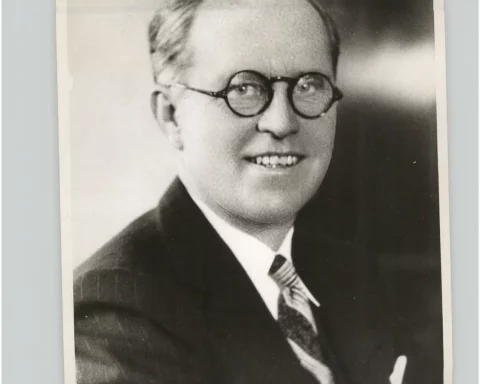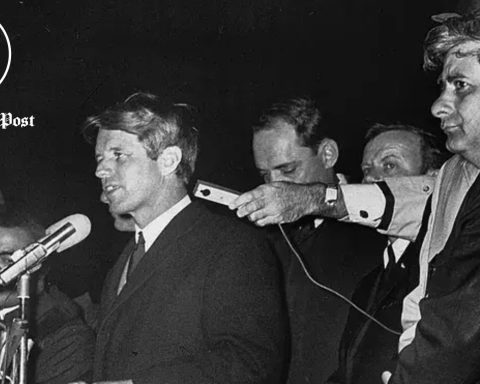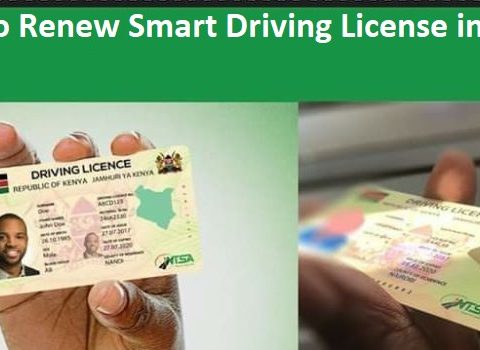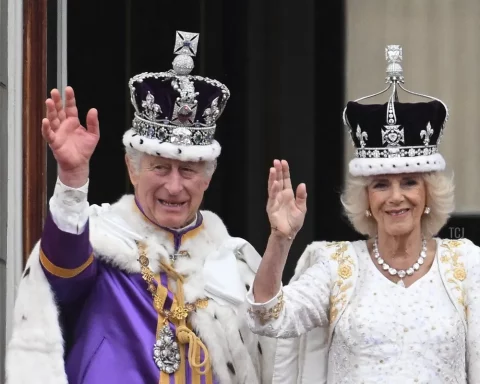The Kenya Airlift: At a key point in the 1960 US presidential campaign, Tom Mboya, a dynamic young leader from Kenya visited Senator John F. Kennedy. Tom Mboya led a campaign of his own that would eventually send hundreds of African students to America for higher education, including Barack Obama Sr., President Obama’s father. Kennedy’s decision to support the effort became an issue in the election and possibly a factor in his narrow victory.

American Education for African Students
Senator John F. Kennedy and Tom Mboya first met in 1959 at a conference on international affairs. Just 28 years old, Mboya was a labor leader and rising political star in Kenya’s liberation movement. At the time, he was on a speaking tour of North America seeking scholarships for Kenyan and other East African students (Kenya Airlift) whose opportunities for higher education under colonial rule were severely limited. Kennedy expressed interest in Tom Mboya’s initiative.

Tom Mboya’s personal quest secured dozens of scholarships from American and Canadian institutions. In what would be known as the Kenya airlift. He also attracted a number of key supporters, including businessman William Scheinman, former baseball star Jackie Robinson, singer Harry Belafonte, and actor Sidney Poitier.
Along with several others, they created the African American Students Foundation (AASF), which raised funds for travel and living expenses. Their fundraising supplemented money raised by African students’ families and tribal groups.
On September 11, 1959, eighty-one students from East Africa arrived in New York City on a chartered flight. After two days of orientation, the students dispersed to colleges and universities throughout the United States and Canada. Based on the success of the 1959 program, AASF obtained new scholarships for approximately 250 additional students from Kenya and six other East African countries. However, they still had to raise $90,000 to cover the cost of airfare. The Kenya Airlift faced financial challenges.
A Desperate Appeal
As the 1960-61 academic year drew closer, the situation was growing desperate. Appeals to the Department of State for help with transportation were rebuffed. Jackie Robinson approached Vice President Nixon on behalf of AASF and Nixon agreed to contact the State Department—again to no avail.

With the future of the project in jeopardy, Tom Mboya returned to the United States. On July 26, he flew to Cape Cod for a meeting with Senator Kennedy. Accompanying Mboya were his brother Alphonse (who was studying at Antioch College), William Scheinman, and Frank Montero, president of AASF.
Scheinman provided a thorough briefing about the situation of the East African students and asked the senator if he would take up their cause with the State Department. Kennedy doubted that he would have any more success on this front than Nixon. He discussed the options for private funding and promised a donation of $5,000 from the Joseph P. Kennedy Jr. Foundation as long as the AASF promised not to publicize his involvement.
SOURCES: JFK Library, JOHN F. KENNEDY, AND THE STUDENT AIRLIFT
Senator Kennedy followed up with a call to his brother-in-law, Sargent Shriver, executive director of the Kennedy Foundation, asking him to find out if other private foundations would make contributions. Shriver’s contacts over the next few days yielded no additional support.

JFK then recommended that the Kennedy Foundation contribute the entire amount needed for the 1960 airlift (Kenya Airlift). In addition to this initial $100,000 contribution, the foundation would pledge up to $100,000 more to assist students with basic living expenses in the United States. The AASF was informed about this decision on August 10 and reminded again not to publicize the donation.
Word did leak out, however, and the Nixon campaign learned that the Kennedy Foundation was financing the airlift (Kenya Airlift). A Nixon campaign staff member then went back to the State Department, which promptly reversed its previous decisions and offered to provide $100,000 for the project. The AASF board ultimately accepted the Kennedy Foundation’s support and urged the State Department to make its funding available to other needy African students.
Philanthropy and Politics
The situation soon erupted into a political issue. A member of Vice President Nixon’s campaign strategy board, Senator Hugh Scott of Pennsylvania, publicly praised the State Department’s grant on August 16, neglecting to mention the prior commitment of the Kennedy Foundation.
The next day on the Senate floor, Senator Scott charged, according to an article in The New York Times “that a charitable foundation operated by the family of Senator John F. Kennedy, the Democratic Presidential candidate had ‘outbid’ the Government and would foot the $100,000 bill. He said this had been done for ‘blatant political purposes.’
Senator Kennedy took the floor and read a telegram from Frank Montero, head of the African American Students Foundation, refuting this charge.
The Massachusetts Senator said it was the ‘most unfair, distorted, and malignant attack I have heard in fourteen years in politics.’
JFK continued by detailing the sequence of events that led to pledging financial support for the African airlift. He concluded his rebuttal of Senator Scott with an assertion that:
“the Kennedy Foundation went into this quite reluctantly… It was not a matter in which we sought to be involved. Nevertheless, Mr. Mboya came to see us and asked for help, when none of the other foundations could give it, when the Federal Government had turned it down quite precisely. We felt something ought to be done. To waste 250 scholarships in this country, to waste $200,000 these people had raised, to disappoint 250 students who hoped to come to this country, it certainly seemed to me, would be most unfortunate, and so we went ahead.”
– Sen JOHN FITZGERALD Kennedy
Other senators, from both sides of the aisle, came out in support of Kennedy. Vice President Nixon also appeared to distance himself from Scott’s accusations. Senator J. William Fulbright, chairman of the Foreign Relations Committee, subsequently attacked the State Department’s apparent surrender to partisan politics and sent a letter to Secretary of State Christian Herter demanding answers to a series of questions regarding his department’s involvement in the affair.
Also, Read KASNEB Accredited Institutions New List 2023!
The controversy received a good deal of attention in the press over the next few weeks. Commentary in African American newspapers was especially critical. A writer in The Pittsburgh Courier editorialized:
“One of Nixon’s henchmen showed State the deep point that the Kennedy gift would be worth a lot of Negro votes, which it would be best for Nixon to have in a tight contest, so all of a sudden State recalled that it had been for the project from the beginning!”
The Pittsburgh Courier
JFK’s slim margin of victory in the 1960 presidential election could not be credited to any single group of supporters. But winning 68 percent of the African American vote was significant, amounting to a 7 percent increase compared with the previous election.
Encouraging Democracy in Africa
Fifteen former French, British, and Belgian colonies in Africa became independent during the summer and fall of 1960. Kennedy repeatedly stressed the importance of the United States reaching out to these emerging nations. Viewing American support as vital to their future, he also framed it as part of the larger Cold War struggle for hearts and minds—as in these remarks to a women’s organization:
I believe that if we meet our responsibilities, if we extend the hand of friendship, if we live up to the ideals of our revolution, then the course of the African revolution in the next decade will be toward democracy and freedom and not towards communism and what could be a far more serious kind of colonialism. For it was the American Revolution, not the Russian revolution, which began man’s struggle in Africa for national independence and national liberty. When the African National Congress in Rhodesia called for reform and justice, it threatened a Boston Tea Party, not a Bolshevik bomb. African Leader Tom Mboya invokes the American dream, not the Communist Manifesto.
-JF Kennedy
By mid-September, “Airlift Africa, 1960” (Kenya Airlift) brought 295 students to New York City on four separate flights. (Many people referred to it as (“The Kennedy Airlift.” or Kenya Airlift) Among those meeting with the students during their orientation week were: Eunice Shriver of the Kennedy Foundation; playwright Lorraine Hansberry, and Malcolm X. The students enrolled in colleges and high schools in forty-one states and several Canadian provinces.
They would face challenges on many levels—dealing with racial segregation (particularly for those on campuses in the South), different social and cultural norms, and much higher costs for basic living expenses. At the same time, small support groups formed around many students, helping them to cope and to feel that they had a home away from home. In the process, several lifelong friendships were formed.
Another Presidential Connection
A large proportion of The Kenya Airlift students would subsequently assume leadership positions in government and the professions in their home countries. One of them was the future Nobel Peace Prize winner Wangari Maathai of Kenya. Another Kenyan, a 23-year-old named Barack Obama, was inspired by the 1959 Kenya Airlift and made his way to the University of Hawaii.
The first African to study in Hawaii, Obama was supported in part by an AASF scholarship fund set up by Jackie Robinson. He graduated at the top of his class. At the university, he met and married an American student named Ann Dunham. Their son, Barack H. Obama Jr., was born on August 4, 1961.

The Kenya Airlift continued through 1963, eventually bringing more than 750 East African students to the United States. Kenya would celebrate its independence in a ceremony on December 12, 1963, three weeks after President Kennedy’s death. Tom Mboya, the founder of the Kenya airlift, went on to hold several senior ministry posts in the new Kenyan government, and many expected he would one day become the nation’s leader. Tragically, he was assassinated in Nairobi in 1969.
Tom Mboya Dream Lives (The Kenya Airlift)
In late 2018 Bob Mwiti and Hon DMK Kiogora, MCA Abogeta West Ward in Meru County rejuvenated the Kenya Airlift dream. The two, Vaite brothers founded the Kenya airlift program, which helps brilliant Kenyan students achieve their dreams of studying in North America regardless of the student’s financial background.
To achieve this mission the organization has partnered with MPOWER Financing; an international student financing organization, which is the official lending partner for unsecured student loans that cover both tuition and living expenses.
The organization also partners with Universities in North America where the organization negotiates tuition fee waivers, and finally, the organization has partnered with The Airlift Sacco to help finance students’ relocation expenses.

As of now, the organization only accommodates ambitious, and incredibly talented Kenyans who are willing to take a leap of faith in joining the tech industry by studying STEM or business-related master’s programs.

To join, you can visit their website; The Kenya Airlift Program. Education remains the greatest equalizer.




